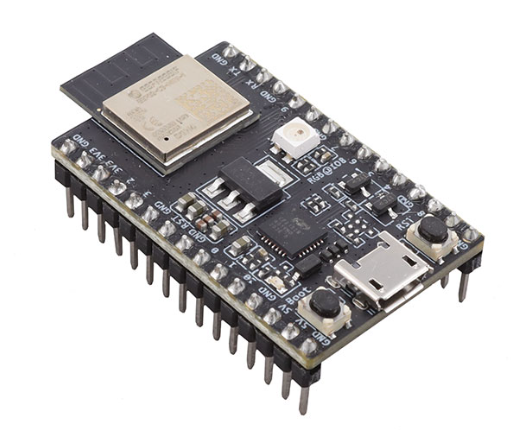ESP32-C3
Espressif is the dominant brand in the industry of microcontrollers and the Internet of Things (IoT). It launched ESP32-C3 in 2021. With evolving needs, Espressif is improving its microcontrollers in terms of connectivity, security, and memory. During such an endeavor, Espressif released ESP32-C3, which has better connectivity, memory, and security than its counterparts and predecessors.
ESP32-C3 is a single-core microcontroller unit that is based on 32-bit, 160 MHz Reduced Instruction Set Computer (RISC)-V architecture. It possesses 2.4 GHz Wi-Fi and low-energy Bluetooth 5 for improved Internet of Things (IoT) connectivity.
Specifications of ESP32-C3
ESP32-C3 has come with enhanced features as compared to the older ESP32. It has better security, connectivity, memory, and power management.
Security
To protect ESP32-C3 from data breaches, unauthorized control of the device, or access to sensitive data, Espressif has incorporated advanced security features in ESP32-C3. These features include security boot, flash encryption, digital signature, and HMAC peripherals.
For security boot, ESP32-C3 has included an RSA-3072-based authentication scheme. This scheme does not allow any malicious application to be programmed on-chip and only allows trusted applications.
The Flash encryption feature is based on AES-128-XTS. This ensures that data remains encrypted in flash and only encrypted application firmware is allowed to execute.
The Digital signature and HMAC peripherals have further added to the security of ESP32-C3. The digital signature is used as a private code or key to protect the device’s identity and firmware, and the HMAC peripheral creates a cryptographic code that protects the device’s firmware.
Connectivity
The ESP32-C3 has ensured high-level connectivity through Wi-Fi as well as Bluetooth. The Wi-Fi of ESP32-C3 uses 802.11 b/g/n IEEE protocol that supports a frequency of 2.4GHz and bandwidth of 20MHz to 40MHz.
However, only Wi-Fi-supporting modules can face connectivity and configuration issues. Therefore, Bluetooth enhances reliability. ESP32-C3 has also increased the range of Bluetooth by using low-energy Bluetooth 5. This protocol can efficiently handle devices in the local area.
Memory
The ESP32-C3 supports an internal 400 KB SRAM and 384 KB of ROM. 16 KB of SRAM is configured for the cache. This increases the usability of memory. Therefore, the memory optimization of ESP32-C3 is greater than simple ESP-32. The ESP32-C3 also supports external flash up to 16 MB, of which 8 MB is instruction memory and 8 MB is data memory.
Peripherals
The ESP32-C3 supports 22 programmable General-Purpose Input/output pins. Similarly, it also has 3 Serial Peripheral Interface (SPI), 2 Universal Asynchronous Receiver-Transmitter (UART), and a DMA controller. It also has a special LED pin, a temperature sensor, a remote control peripheral, and a USB serial adapter. The ESP32-C3 has two integrated 12-bit ADCs with 6 analog-enabled pins.
Power Consumption
The power consumption of ESP32-C3 is very low. The operating voltage of ESP32-C3 is 3.0V to 3.6V. The Wi-Fi and Bluetooth modules are also low-energy modules and do not consume much power, Therefore, ESP32-C3 is very suitable for small battery IoT devices.
How to Power ESP32-C3 Board?
There are three mutually exclusive ways to provide power to the board:
- Micro-USB Port
- Default power supply 5V and GND pin headers
- 3.3V and GND pin headers
USB UART Chip and USB Connector in ESP32-C3
The ESP32-C3 uses the following USB UART chips and USB serial connectors to connect to the PC for communication.
Voltage Regulator Used in ESP32-C3
The ESP32-C3 operated in the voltage range of 3.3V to 3.6V. However, we supply it 5V from a micro-USB port or default power supply pins. So, to regulate this power supply to 3.3V for the board, there is an internal 3.3V Low Drop-Out (LDO) voltage regulator installed on ESP32-C3 that regulates voltage for the board.
Main Highlights of ESP32-C3
The list given below will help you to have a quick overview of the key features of ESP32-C3
CPU and Memory
- Single Core Processor [up to 160MHz]
- 32-bit RISC-V Architecture
- 384 KB ROM
- 400 KB SRAM
- External Flash supported
Wi-Fi
- IEEE 802.11/b/g/n protocol
- Bandwidth (20MHz-40MHz)
- Frequency 2.4GHz
- Antenna diversity
Bluetooth
- Low Energy Bluetooth 5
- Power Mode of 21 dBm
- High-speed maximum up to 2Mbps
Security
- Digital Signature and HMAC
- Encrypted Flash
- Cryptographic Security
- Permission Required to run a program
Advanced Peripheral Interfaces
- 22 programmable GPIO
- 3 Serial Programmable Interfaces
- 2 UARTs
- PWM Controller
- DMA Controller
- One temperature Sensor
- 2* 54 General Purpose Timer
- Analog and Digital Watchdog Timer, one each
Applications of ESP32-C3
The ESP32-C3 offers an extensive range of applications. They are used in designing smart home systems, industrial automation, smart agriculture, electronics, sensors, health care, etc.
Conclusion
Espressif has developed ESP32-C3 to overcome the limitations of ESP32. The new module developed by Espressif has improved security, connectivity, memory, and power consumption. Due to these enhanced features, it is now readily being used in automated systems.

